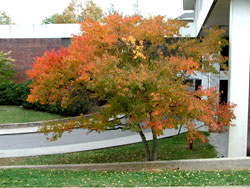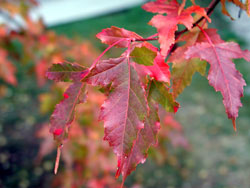Resource Library
Plant of the Week: Maple, Amur
The University of Arkansas System Division of Agriculture does not promote, support or recommend plants featured in "Plant of the Week." Please consult your local Extension office for plants suitable for your region.
Plant of the Week
Amur Maple
Latin: Acer ginnala

Fall is the season for maples, of which there are many. The large trees with enormous mops of bright red and orange foliage get most of the press in autumn, but a number of smaller maples are available and have something to offer in smaller spaces. One of these lesser-known and easy-to-grow species is the Amur Maple, Acer ginnala.
Amur maple grows as a low-branched small tree or large shrub reaching 15 to 20 feet in height and spread. Most Amur maples are seedling grown, so there is considerable variation in plant form and fall color, but most trees branch a foot or two from the ground and produce smooth, gray-brown bark. As young trees they are very fast growing.
The leaves are 2 to 3 inches long, three-lobed and glossy green in the summer. In the fall, color ranges from yellow to orange and red. Several color combinations will often be seen on the same tree. Fall color development occurs at a young age. Trees produce heavy crops of seeds in the fall, and an occasional seedling may be found amongst the flowers.
The Amur maple's common name comes from the name of the river in northern Asia from which it was collected during a four-year long expedition by Russian botanist Carl Maximowicz (1827-1891). His Amur River expedition was from 1853 to 1857. Seeds of a number of common garden plants - including the Amur maple, Amur honeysuckle and Amur corktree - were introduced to the West when he returned to the St. Petersburg Botanical Garden. Maximowicz also spent five years collecting plants in Japan, so many common garden plants were identified and collected as a result of his work.
The Amur River is 1,755 miles long and runs generally east from near the eastern end of Mongolia to the Sea of Japan. It forms the border between China and Russia during much of its length. Most of its watershed is between 45 and 50 degrees North latitude, an area in this hemisphere equivalent to the U.S.-Canadian border.

The Amur maple is useful for screening, creating a backdrop for garden plantings or wherever a small specimen plant is needed. Because it is hardy from zones 3 through 8, it has considerable root hardiness and can be used in above-ground containers and raised beds where other more tender species might freeze out. It will grow equally well in full sun or light shade. Fall color development is equally good for plants growing in shady portions of the garden.
Like all maples it has a shallow, fibrous root system, so planting a groundcover planting at the same time as the tree is planted is a good idea. A number of selected clones are available with 'Flame,' 'Embers' and 'Red November' good choices for reliable red color development.
By: Gerald Klingaman, retired
Extension Horticulturist - Ornamentals
Extension News - October 29, 2010
The University of Arkansas System Division of Agriculture does not maintain lists of retail outlets where these plants can be purchased. Please check your local nursery or other retail outlets to ask about the availability of these plants for your growing area.